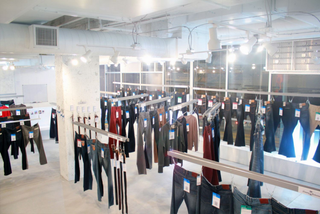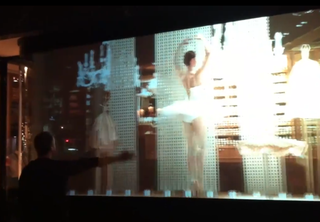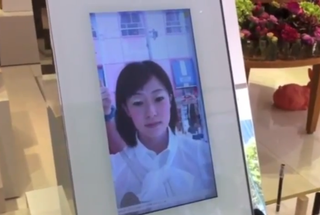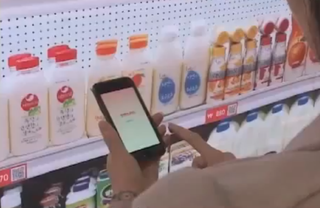High-Tech Shopping: Meet the Future of Retail

Browsing through a store's clothing selection, trying things on and dealing with a salesperson is so last-century. Now tons of people do a bulk of their shopping, if not all of it, from the comfort of their own home, clicking away at what they like and sending back what doesn't fit. According to a 2012 Forrester report, 58 percent of the U.S. population will be online shoppers by 2016. But that doesn't mean the mall needs to become a ghost town.
Brick-and-mortar locations are finding high-tech ways to combat Web shoppers by adding a digital angle to the in-store experience. In one such example a 3D scanner helps you find the perfect pair of jeans. In another, a men's jeans store lets you go from start to finish without dealing with a pesky sales rep. Will these moves bring back the browsers?
Me-Ality Size-Matching Station
Every woman knows that jeans shopping can be frustrating, exhausting and often not worth the effort. You try on 20 different pairs, decide between a few, then decide you aren't satisfied and go home empty-handed. Me-Ality Size-Matching Station aims to simplify the process, and suggests that perhaps you just aren't trying on the right brand or style.
The 3D scanner, which has locations at 20 malls nationwide as well as five Bloomingdale's locations, analyzes your body and determines what brand, size and style will fit you best -- all in 10 to 15 seconds. How does it work? Me-Ality scans around your body twice, using millimeter wave technology to collect more than 200,000 measurements. The cool part is that you don't have to take off any of your clothes: The technology receives low-power signals that reflect off the moisture in your skin to make its measurements.
I went to the Bloomingdale's Flagship store in New York City and tested the Me-Ality out. The Size-Matching Station looks a lot like an airport scanner, and a wand circles you twice to take your measurements. The whole process took less than 10 seconds. You have to stand in a specific area within the machine, and while we got scanned, shoppers looked on and many wanted to be next to try it out.
Our unique barcode promptly printed and I scanned it into the Me-Ality interface, which showed me a full listing of jeans that were good fits for me. Me-Ality lets you sort by brand, price and fit. I tried on a pair of jeans (which wasn't even one of the top matches for us) and it fit me perfectly. I'm on the short side, yet the jeans weren't too long, and they hugged my body in the right ways without feeling too tight.
Stay in the know with Laptop Mag
Get our in-depth reviews, helpful tips, great deals, and the biggest news stories delivered to your inbox.
Sephora + Pantone Color IQ
Everyone has seen a woman who has made some poor choices in makeup. Her face might be three shades darker than her body, or her skin tone may be far more olive than the peach shade she chose for her cheeks. Tons of women wear the wrong shade of makeup for their skin tone, purely because they just don't know which shade is appropriate for them. According to Sephora, women on average purchase seven foundations before they find a perfect match, and only 24 percent of Sephora clients consider themselves loyal to their foundation.
Beauty retailer Sephora teamed up with color authority Pantone LLC to create a technology that helps people choose the right shades of foundation, moisturizer and powder. Color IQ consists of a scanner and a tablet interface. The scanner scans three clean parts of your skin, averages the scans and assigns you a Pantone skin tone number. A Sephora pro then references the Universal Skintone Guide, an online database on the tablet that helps find the precise shade of foundation for you from among 1,000 possibilities.
MORE: Top 5 Apps that Help You Earn Extra Money
I went to the Times Square Sephora to see if Color IQ could find me an accurate makeup shade. I have a ton of freckles, so Sephora pro Hector had to search a bit to find clean areas of skin. For best results, I was advised to remove makeup, moisturize and abstain from working out 30 minutes before using Color IQ. Hector took my three scans in less than 15 seconds, then waited for my skin tone number, which only took a few seconds. He then plugged that code into the Universal Skintone Guide on the tablet, and I was presented with a list of products for my skin tone, as well as the option to filter by anything from brand to SPF. I picked out a tinted moisturizer, and Hector applied it. I was shocked by how close of a match the product was to my skin tone.
Hointer
This Seattle men's clothing store understands that male shoppers are hunters seeking something specific so they can get in and out. There's no perusing an assortment of sweaters or mindless conversation with the sales girl. There's online shopping, which is quick and easy, but there's always the possibility that clothes bought online don't fit. Hointer, started by Amazon vet Nadia Shouraboura, is a physical store that has all the perks of online shopping.

Image credit: Hointer blog
Enter the minimalist store and all you'll see are hanging rails that suspend rows and rows of jeans, all from high-end brands. There's one pair of jeans per style, so you don't sift through piles of jeans to find your size. Instead, download the Hointer app and scan the QR code on the jeans you like. Once you've navigated your way through the store and tracked down all the jeans you want to try on, tap Try On in the app and head toward the fitting room. When you get there, your jeans will already be waiting for you, dropped into your fitting room through a chute.
From start to finish, there's no human interaction (unless you want it -- there is one store representative). If you need a different size, add a new size to your list on the app. Discard what pairs you don't want by tossing them in a different chute. Even paying is human-free: Your app updates based on what jeans you end up with, then you select your fitting room at a touch-screen terminal and swipe to pay using your credit card.
The original Hointer location opened in late 2012, and business has been good. Good enough to open a location in Palo Alto, Calif., and another Seattle location at the end of May.
MORE: 10 Best Flight Apps
Repetto Interactive Window Display
In an extravagant marketing scheme and an innovative technological display, Parisian luxury shoe retailer Repetto thought of a new way to draw the crowds to its store during this year's Paris Fashion Week. The interactive display transformed the storefront's window into a stage in which holographic videos of ballerinas danced across, wearing the famed shoes. Each ballerina wore a different style or shoe, and passersby could stand on a certain spot on the sidewalk to interact with the display. Directions to wave your hands back and forth to scroll through the selections, similar to flipping pages back and forth in catalogs, are placed directly in front of where you stand. Essentially, gesture-tracking technology created a live catalog.

Image credit: Guillaume S - YouTube
In a video showing the Repetto display in action, passersby quickly picked up the technology and lingered in front of the store, even if they had seemed in a hurry before noticing the holographic videos and gesture-tracking technology.
Shiseido Mirai Mirror
In almost any makeup store you can try on the products before you buy. However, as convenient as that is to make sure you're purchasing something that looks good on you, it's kind of unhygienic. Think about all the people before you who have tested out those products. Sure, you shower on a daily basis, but who knows if they do, and even worse, think of the eye or oral infections they may carry.
Thankfully, Japanese beauty retailer Shiseido provides an alternative. The makeup company's Mirai Mirror in its Tokyo store uses technology to show you how you'll look with specific makeup without physically applying that makeup. Here's how it works: Shoppers pick out any makeup they're interested in, then head over to the cosmetic mirror and scan those products using the scanner next to the computer screen. They stand in front of the Mirai Mirror so it can use their image, then it virtually applies the product to the image of their face.

Image credit: CScoutJapan - YouTube
If you decide you like a product, the technology displays additional info such as application suggestions and beauty tips on its computer screen.
Tesco Homeplus
High-tech shopping doesn't stop at clothes and accessories. In South Korea, it's expanding to daily necessities like groceries.
With your busy schedule, who has time to go to the grocery store? Delivery grocery services has been on the rise for the past few years, both because it's easy to do at one's desk and because, especially in cities where people walk and take public transportation rather than drive, it's a hassle to carry heavy bags of groceries home.
A 2012 project in South Korea aimed to eliminate even the computer as a middle-man, with a virtual store located in the Seoul subway system. Instead of ordering groceries from your desk to be delivered to your doorstep, Tesco Homeplus let shoppers pick out what they needed while waiting for their morning train.
MORE: 10 Weirdest and Most Useless Apps
Here's how it works: The walls of the Seonreung subway station became a virtual display, advertising more than 500 of the most popular products, from milk to pet food to stationary. If users wanted a product, they downloaded the Homeplus app then scanned the QR code on that product. As long as the order was placed before 1 p.m., that shopper's items would be delivered to their doorsteps that evening, at a time of their choosing.

Image credit: Majed AlSaeed - YouTube
Although it's still in early stages, high-tech shopping is already starting to solve some of shoppers' biggest problems: I can't find a pair of jeans that fit. I don't want to deal with a salesperson. I don't know what makeup is right for me. I don't feel like physically going to the store and hauling home my purchases. And with a slew of shopping apps out there, soon shoppers won't even need to ever visit a store -- if they don't want to. We can only imagine what's next with high-tech shopping by brainstorming of other shopping problems: I wish I could see how clothes fit me without leaving my apartment, for instance.
